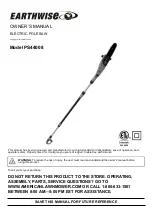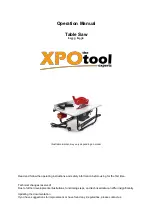
15
ing pressure may lead to rapid deterioration of the blade
and a decrease in performance in terms of finish and
cutting precision.
• Avoid accidental starts: do not press the start button
while inserting the plug into the socket.
Putting into operation
Setting the saw bench, Fig. 2
Setting the angle scale
• Release the star button (1) and bring the saw bench (2)
to a right angle (3) in relation to the saw blade.
• Use a 90° angle tc measure the right angle between
the blade and the bench. The saw blade be 90° to the
angle.
• Close the star button again when the distance between
the blade and the 90° angle is at a minimum. The
bench should then be at 90° to the saw blade.
• Release the lock screw and bring the indicator to the
zero position. Fasten the screw. Please note: the angle
scale is a useful piece of supplementary equip ment,
but should not be used for precision work. Use scrap
wood for saw tests, adjust the bench if neces sary.
Note: The bench should not be on the motor block, this can
cause undesireable noise.
Horizontal saw bench and diagonal cuts, Fig. 2+3
• The saw bench can be positioned into a 450 diagonal
position or be left in the horizontal position.
• You can read off the approximate slope angle by using
the angle scale located under the work bench. For more
exact adjustment, use scrap wood for some saw tests;
adjust the bench if necessary.
me ainsi que les instructions de service.
Mise en service
Réglage de la table de sciage, Fig. 2
Aménagement de I‘échelle d‘angles
• Ouvrez le bouton de blocage (1) et mettez la table de
sciage en angle droit par rapport à la lame de scie.
• Utilisez un angle de 90° pour mesurer I‘angle droit en
-
tre la lame et la table. La lame de scie devrait être
étroite ment appuye contre I‘angle à 90°,
• Quand la distance entre la lame et I‘angle à 90° est au
minimum, refermez leboutonde blocage. La table de-
vrait alors étre à 90° par rapport à la lame de scie.
• Ouvrez la vis de blocage de I‘échelle et mettez I‘indica
-
teur en position zéro. Serrez la vis. Corrigez en suite la
vis de position zero sous la table. Prenez garde s‘il vous
plait : I‘échelle d‘angles est une pièce supplé mentaire
utile, mais elle ne devrait pas étre utilisée pour des
travaux de précision. Utilisez du bois de déchet pour
quelques sciages d‘essai; réajustez la position de la ta-
ble si nécessaire.
Remarque:la table ne doit pas être appuvêele bloc du moteur.
Ceci risque de provoquer des bruits indêsirables.
Table de sciage horizontale et déoupages de blais, Fig. 2+3
• La table de sciage peut être inclinée à 45° à gauche ou
laisseé en position horizontale.
• Vous trouverez sous la table de travail l‘échelle d‘angles
pour lire I‘angle d‘inclinaison approximatif.
Pour un réglage plus précis, utilisez du bois de dechet
pour quelques sciages d‘essai; réajustez la position de la
table si nécessaire.
















































